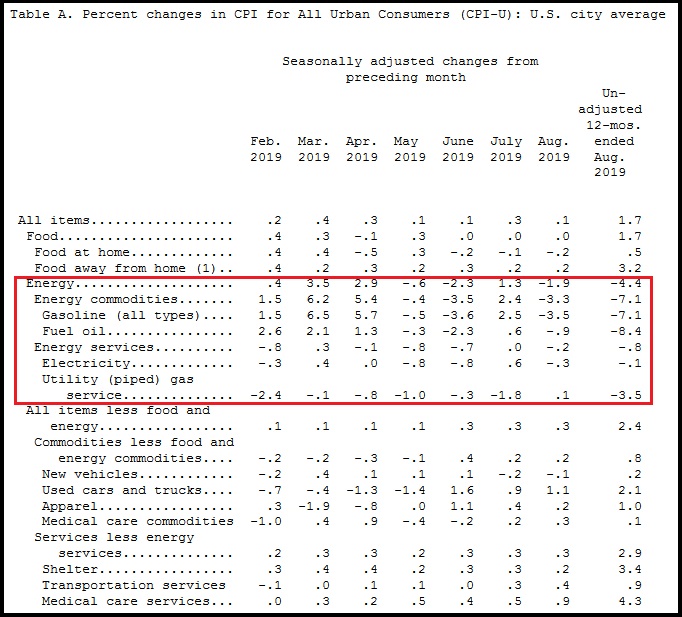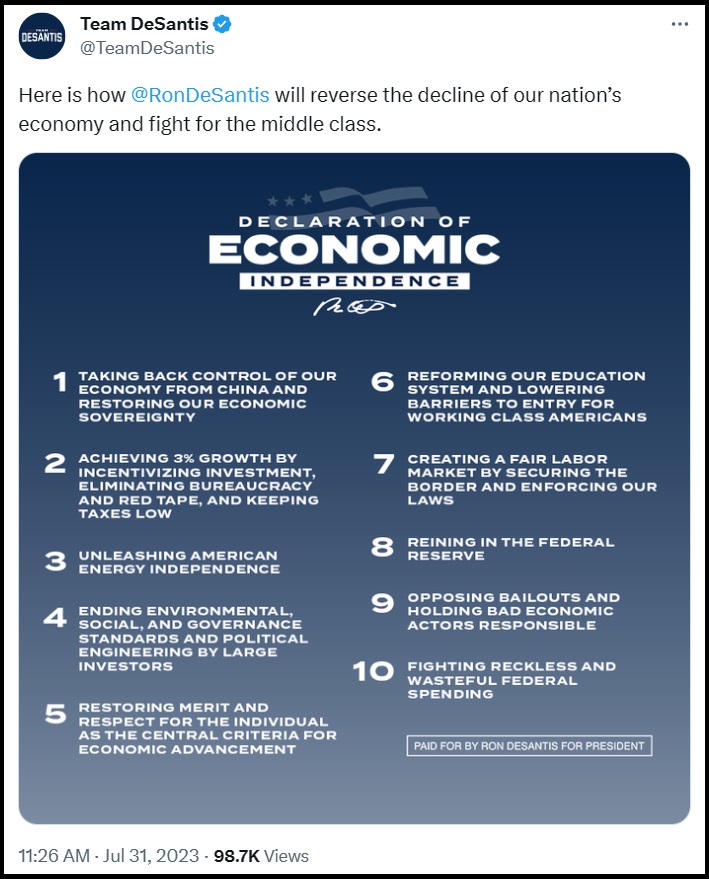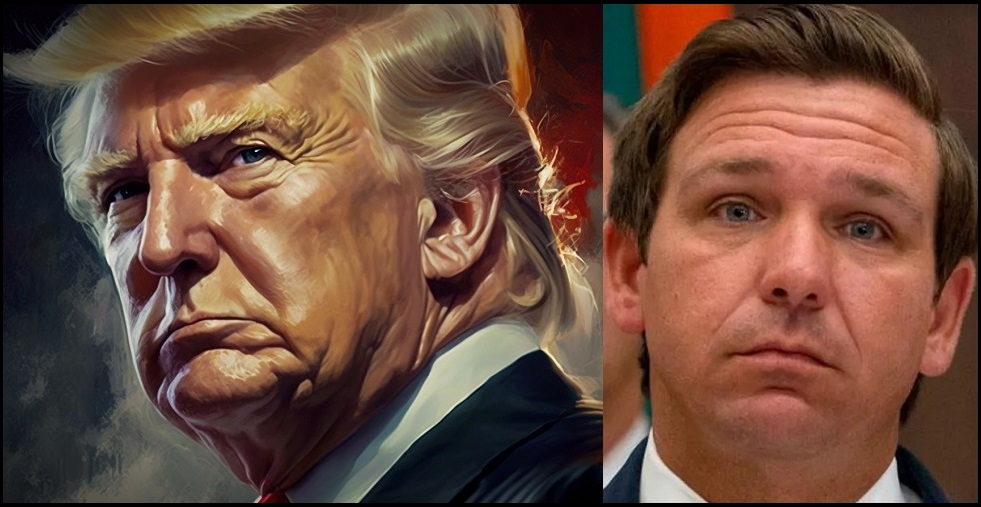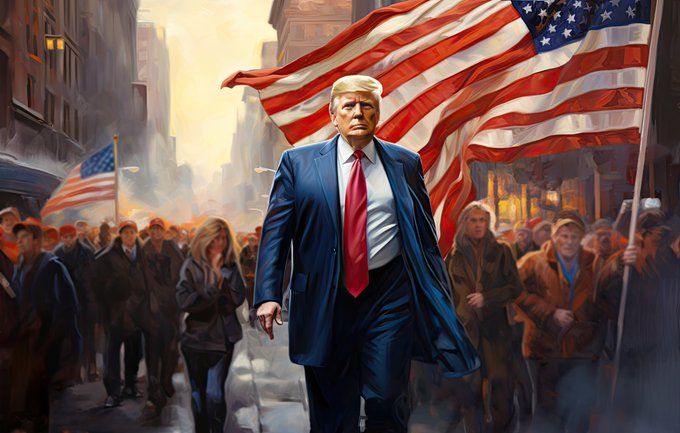“Platitudes”, that’s the best word to describe what the DeSantis campaign previously claimed would be a substantive economic policy outline from the Florida governor. As the policy was unveiled in New Hampshire yesterday, I watched it all {Direct Rumble Link Here} to see what it would cover and how DeSantis would deliver it. Summary, major fail.
First, I must admit to coming to any economic policy outline as presented with a laser focus. You tell me you have an economic policy, and you have my full attention. Why? Because the economic policy of a federal candidate will ultimately determine monetary policy, fiscal policy and foreign policy. It is the only national policy we cannot affect from a local level, yet we are necessarily impacted by it and cannot avoid it.
MAGA starts with MAGAnomics. So, to say I get into the weeds on this, would be a soft understatement.
Unfortunately, but not unexpectedly, what Ron DeSantis outlined yesterday was a series of 10-point meaningless platitudes. If the UniParty policy teams of Pete Buttigieg and Kamala Harris got together over a weekend with Mitch McConnell and Kevin McCarthy, they would create a think-tank-driven UniParty economic policy outline very similar to what Ron DeSantis presented yesterday.
Platitudes, soundbites and structurally incoherent gibberish – presented with a word assembly that amounts to nothing.
“We will declare our economic independence from the failed elites that have orchestrated American decline, from the reckless federal spending that has inflated prices and plunged this nation to the brink of bankruptcy.” ~ Ron DeSantis 7/31/23
Declare away doofus, you can declare all you want but it takes an actual set of targeted actions to move from declaration to outcome. Those same “failed elites that have orchestrated American decline” are the same people financing your run for office.
I’m sure somewhere in a Pete Buttigieg kind of way, that soundbite might have seemed like a good sentence; but in reality, it’s gibberish and parseltongue.
You can see the 10-point outline above. Generally speaking, when the ten points are outlined the speech and accompanying policy therein would describe exactly what action takes place in each of the points…. Nope, not for DeSantis it doesn’t. Instead, what DeSantis does in his policy framework is take each of the ten points and then describe what they mean.
DeSantis describes what is referenced by each of his ten points, he does not outline the specific action that takes place within them. That’s how you can tell when a think-tank puts meaningless platitudes into a format for a candidate to speak. In this instance the think tank is the stunningly typical Club for Growth, U.S. Chamber of Commerce and the multinationals who are funding the DeSantis campaign operation.
Take point #1 as an example, dealing with China. Here’s the policy:
- DeSantis will end our abusive relationship with the CCP, reverse our ever-increasing trade deficits, ban imports of goods made from stolen intellectual property, strengthen protections to stop child and forced labor, and end China’s preferential trade status.
- DeSantis will demand that American companies act in accordance with American interests — which means preventing companies from sharing critical technologies with China and banning the sale of strategic assets like farmland to CCP members and their affiliates.
- DeSantis will incentivize the repatriation of U.S. capital from China through strategic tax abatements and aligning market incentives with strategic goals to help secure our supply chains and invest in America.
.
“DeSantis will end our abusive relationship with China.” How? Doesn’t say.
“DeSantis will demand”…. How? Doesn’t say.
“DeSantis will incentivize”…. How? Doesn’t say.
See the problem?
The era of hopeful optimism that a Republican candidate will actually take an action to fulfill the policy “demand” is over. The rustbelt sits there, staring at any Republican politician who would dare say the Republican Party has protected Main Street from the vulture capitalism of Wall Street.
This DeSantis economic policy is an assembly of meaningless platitudes with no substantive action presented as policy to back up the intention. Worse still, not only is there no action outlined, but there’s also no action that could be outlined that is not against the interests of the very people who put the outline together.
The people constructing this language (for DeSantis to read) have no intent, thought or purpose of actually doing anything to act upon any of the economic issues. Within all of the remaining nine points it’s the same. It’s all meaningless gibberish.
Compare the DeSantis policy to the Trump policy. Here’s Trump’s “AGENDA 47” China plan:
♦ENDING RELIANCE ON CHINA: President Trump’s America First trade policy will completely eliminate U.S. dependence on China–the primary beneficiary of Democrats’ globalist agenda.
In addition to universal baseline tariffs on most foreign goods, President Trump’s plan will reclaim our economic independence from China. President Trump will revoke China’s Most Favored Nation trade status and adopt a 4-year plan to phase out all Chinese imports of essential goods—everything from electronics to steel to pharmaceuticals. This will include strong protections to ensure China cannot circumvent restrictions by passing goods through conduit countries.
President Trump will establish new rules to stop U.S. companies from investing in China and stop China from buying up America, allowing only those investments that serve American interests.
President Trump will ban federal contracts for any company that outsources to China. (link)
See the difference? The DeSantis campaign assembles talking points, while the Trump China plan is direct, specific and actionable.
The DeSantis economic plan is well described by this segment by Steve Bannon {Direct Rumble Link}:
Fortunately, we do not have to guess which candidate has the right path. We have President Trump’s actual economic policy results to look at and see how the expansion of the economy was creating the type of growth that would sustain Social Security and Medicare. This was/is MAGAnomics at work.
…. Make America Great Again!
We know it works, because we have the results to cite.
It was the Fourth Quarter of 2019…..
Right before the pandemic would hit a few months later…. Despite two years of doomsayer predictions from Wall Street’s professional punditry, all of them saying Trump’s 2017 steel and aluminum tariffs on China, Canada and the EU would create massive inflation, it just wasn’t happening!
Overall year-over-year inflation was hovering around 1.7 percent [Table-A BLS]; yup, that was our inflation rate. The rate in the latter half of 2019 was firmed up with less month-over-month fluctuation, and the rate basically remained consistent. [See Below] The U.S. economy was on a smooth glide path, strong, stable and Main Street was growing with MAGAnomics at work.

A couple of important points. First, unleashing the energy sector to drive down overall costs to consumers and industry outputs was a key part of President Trump’s America-First MAGAnomic initiative. Lower energy prices help the worker economy, middle class and average American more than any other sector.
Which brings us to the second important point. Notice how food prices had very low year-over-year inflation, 0.5 percent. That is a combination of two key issues: low energy costs, and the fracturing of Big Ag hold on the farm production and the export dynamic:
(BLS) […] The index for food at home declined for the third month in a row, falling 0.2 percent. The index for meats, poultry, fish, and eggs decreased 0.7 percent in August as the index for eggs fell 2.6 percent. The index for fruits and vegetables, which rose in July, fell 0.5 percent in August; the index for fresh fruits declined 1.4 percent, but the index for fresh vegetables rose 0.4 percent. The index for cereals and bakery products fell 0.3 percent in August after rising 0.3 percent in July. (link)
For the previous twenty years food prices had been increasingly controlled by Big Ag, and not by normal supply and demand. The commodity market became a ‘controlled market’. U.S. food outputs (farm production) was controlled and exported to keep the U.S. consumer paying optimal prices.
President Trump’s trade reset was disrupting this process. As farm products were less exported the cost of the food in our supermarket became reconnected to a ‘more normal’ supply and demand cycle. Food prices dropped and our pantry costs were lowered.
The Commerce Dept. then announced that retail sales climbed by 0.4 percent in August 2019, twice as high as the 0.2 percent analysts had predicted. The result highlighted retail sales strength of more than 4 percent year-over-year. These excellent results came on the heels of blowout data in July, when households boosted purchases of cars and clothing.
The better-than-expected number stemmed largely from a 1.8 percent jump in spending vehicles. Online sales, meanwhile, also continued to climb, rising 1.6 percent. That’s similar to July 2019, when Amazon held its two-day, blowout Prime Day sale. (link)
Despite the efforts to remove and impeach President Trump, it did not look like middle-class America was overly concerned about the noise coming from the pundits. Likely that’s because blue-collar wages were higher, Main Street inflation was lower, and overall consumer confidence was strong. Yes, MAGAnomics was working.
Additionally, remember all those MSM hours and newspaper column inches where the professional financial pundits were claiming Trump’s tariffs were going to cause massive increases in prices of consumer goods?
Well, exactly the opposite happened [BLS report] Import prices were continuing to drop:
This was a really interesting dynamic that no-one in the professional punditry would dare explain.
Donald Trump’s tariffs were targeted to specific sectors of imported products. [Steel, Aluminum, and a host of smaller sectors etc.] However, when the EU and China respond by devaluing their currency, that approach hit all products imported, not just the tariff goods.
Because the EU and China were driving up the value of the dollar, everything we were importing became cheaper. Not just imports from Europe and China, but actually imports from everywhere. All imports were entering the U.S. at substantially lower prices.
This meant when we imported products, we were also importing deflation.
This price result is exactly the opposite of what the economic experts and Wall Street pundits predicted back in 2017 and 2018 when they were pushing the rapid price increase narrative.
Because all the export dependent economies were reacting with such urgency to retain their access to the U.S. market, aggregate import prices were actually lower than they were when the Trump tariffs began:
[…] Prices for imports from China edged down 0.1 percent in August following decreases of 0.2 percent in both July and June. Import prices from China have not advanced on a monthly basis since ticking up 0.1 percent in May 2018. The price index for imports from China fell 1.6 percent for the year ended in August.
[…] Import prices from the European Union fell 0.2 percent in August and 0.3 percent over the past 12 months.
So yes, we know President Trump can save Social Security and Medicare by expanding the economy with his America First economic policy. We do not need to guess if it is possible or listen to pundits theorize about his approach being some random ‘catch phrase’ disconnected from reality. Yes folks, we have the receipts.
This was MAGAnomics at work, and this is entirely what created the middle-class MAGA coalition. No other Republican candidate has this economic policy in their outlook because all other candidates are purchased by the Wall Street multinationals.
America First MAGAnomics is unique to President Trump because he is the only one independent enough to implement them.
That’s just the reality of the situation. They hate him for it…
- Donald Trump American Solutions Part I
- Donald Trump American Solutions Part II
- Donald Trump “America First” Conservative Solutions Part III
- Donald Trump “America First” Conservative Solutions Part IV
Author’s note as said in 2016: “If I absolutely did not believe this economic model was doable, I would never expand the concept and place advocacy upon it. I am an absolute believer that we can, as a nation, reignite a solid manufacturing base and generate an expanding middle class.” Yes, I bet on Trump, and he was right.





